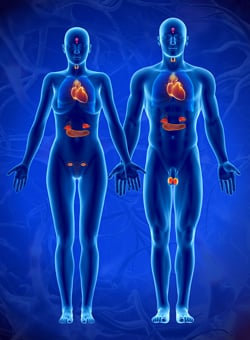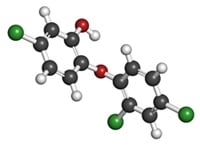Hormone Precision Keeps Us Healthy
 Hormones are substances secreted by glands throughout your body. They regulate everything from hunger to reproduction and influence nearly every cell, organ, and metabolic function. Together, hormones and glands make up the endocrine system.
Hormones are substances secreted by glands throughout your body. They regulate everything from hunger to reproduction and influence nearly every cell, organ, and metabolic function. Together, hormones and glands make up the endocrine system.
How do hormones activate “target cells” on specific organs? Each one connects to a complementary receptor, which is activated depending on:
This “hormone signaling” is a delicate process. For people to stay healthy, hormones must be released in the right amounts, and glands must be able to adjust the release of hormones in response to a changing environment.
 EDCs can interfere with the steps in hormone signaling. They can trick a receptor by mimicking a hormone, which can turn on a hormone response and inappropriately trigger hormonal processes. Or they can bind to a hormone’s receptor and block activation, prevents appropriate hormonal processes from taking place.
EDCs can interfere with the steps in hormone signaling. They can trick a receptor by mimicking a hormone, which can turn on a hormone response and inappropriately trigger hormonal processes. Or they can bind to a hormone’s receptor and block activation, prevents appropriate hormonal processes from taking place.
Even a tiny amount of EDC can trigger this response. The effect is completely different from acute toxicity, which is when a cell or tissue is bombarded with a harmful substance and dies. This difference, the ability of EDCs to affect cells and tissues at even miniscule amounts, is one of the reasons why conventional testing strategies don't work well for EDCs. Many of these methods aren’t set up to study effects from such tiny doses. That’s why we advocate for upgrading testing to reflect actual EDC threat.
One of the greatest challenges is that EDCs are all around us and have been for decades. The annual global production of plastics has grown from 50 million tons to 300 million since the 1970s. This surge in manufacturing in the United States, European Union, China, and elsewhere has contributed to the addition of thousands of new chemicals into our environment—ones that haven’t been tested for safety.
 These chemicals can leach into our soil and water. They can move through the animal kingdom as animals eat plants and bigger animals eat smaller ones. Once in our environment, EDCs can enter our own bodies through eating, drinking, or breathing, and can even be transferred from mother to fetus or infant.
These chemicals can leach into our soil and water. They can move through the animal kingdom as animals eat plants and bigger animals eat smaller ones. Once in our environment, EDCs can enter our own bodies through eating, drinking, or breathing, and can even be transferred from mother to fetus or infant.
Studies indicate that nearly all people have a detectable level of EDCs in our blood, urine, placenta, or other body tissues. This means that we cannot completely avoid or remove EDCs, but what we can do is make informed choices about our exposure to reduce its effects on our health.
 We know how some EDCs harm us, but it’s estimated that more than 1,000 of the over 85,000 man-made chemicals may be EDCs based on how they interact with our endocrine system. However, most of those 85,000 manmade chemicals have never been fully tested for safety, so the problem may be even more far-reaching than current research shows.
We know how some EDCs harm us, but it’s estimated that more than 1,000 of the over 85,000 man-made chemicals may be EDCs based on how they interact with our endocrine system. However, most of those 85,000 manmade chemicals have never been fully tested for safety, so the problem may be even more far-reaching than current research shows.
Scientists are also concerned because as the global production of chemicals has increased, so has the incidence of endocrine-associated disorders. These include infertility, impaired brain development, diabetes, and certain cancers among other conditions.
New technology and scientific approaches have shed light on the impact of EDCs and the urgent need to address potential public health problems. The more we discover about EDCs, the clearer it is that we need a fuller picture of how they affect us.

We rely on your voice to advocate for our policy priorities. Join us to show our strength as a community that cares about endocrinology. Contact your US representatives or European Members of Parliament through our online platform. Take action and make a difference today.